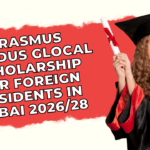$100K Fee for H-1B Visa: Best Alternatives for International Students
The United States has long been the best place for international students to go to get a world-class education and find work. In the past, a lot of these students used the H-1B visa to go from being a student (F-1 visa) to having a job for a long time or even getting a green card. But new revisions to the rules have made things harder. The most talked-about topic among students and businesses right now is USA $100K Fee for H-1B Visa: Best Alternatives for International Students. The U.S. government has set up a new price structure that makes it far more expensive to hire foreign workers through the H-1B program.
This blog post talks about the USA fee of H-1B visa for International Students, the effects of the $100K fee of H-1B visa for International Students, the specifics of the USA new H-1B visa fee for International Students, and looks at practical options for students. It also talks about how important it is to have a study abroad adviser to help you deal with all of this.
Understanding the H-1B Visa
The H-1B visa is a work visa for non-immigrants that lets U.S. companies hire foreign workers in specialised industries, primarily in IT, engineering, finance, research and healthcare. The H-1B visa has been a bridge enabling international students who graduated from U.S. institutions to move from an F-1 visa (student status) to work permission for decades. It is one of the most sought-after visas in the world.
The New $100K H-1B Fee: What Changed?
1. Details of the Policy
- In September 2025, the U.S. government announced a USA new H-1B visa fee for International Students that required a one-time payment of $100,000 for new H-1B petitions.
- Only new applicants have to pay the charge. People who already have H-1B visas or are renewing them are not affected.
- Employers, not students, are legally required to pay this fee
- There is a waiver for national interest responsibilities, which means that some industries or specific jobs may not have to follow this rule
2. Why Was This Introduced?
- Keeping employment in America: To make it less appealing for businesses to hire less expensive foreign workers.
- Making money: The government expects this initiative to bring in billions of dollars.
- Selective immigration: H-1B only lets you hire people who are very competent or valuable.
3. Key Takeaways
The USA fee for H-1B visa for International Students has a big impact on how employers decide who to hire. Many firms, especially new ones and small ones, can’t afford to pay such a high cost, which makes it harder for new graduates to get work.
Impact of the $100K Fee on International Students
- Fewer chances to get sponsorship. The $100K fee of H-1B visas for International Students will make it less likely that firms will hire new graduates.
- Preference for Senior Talent: Companies may only sponsor highly skilled people, not new graduates from other countries.
- Shift to Other Countries: Students may start to like Canada, the UK or Australia more because their post-study work rules are more accommodating.
- Uncertainty for Current F-1 Students: Students who are about to graduate aren’t sure what jobs or visa sponsorships they will get.
Best Alternatives to the H-1B Visa
The H-1B visa has long been the major means for international graduates to get jobs in the US, but the new USA $100K Fee for H-1B Visa: Best Alternatives for International Students shows how important it is to look into other choices. There are many good options for people who want to work and live in the U.S. or another country.
Optional Practical Training (OPT) and STEM OPT Extension
Optional Practical Training (OPT) is one of the most prevalent options for people who don’t want to get an H-1B. It lets F-1 students work in the U.S. for 12 months after they finish their degree. The STEM OPT extension gives graduates in science, technology, engineering and math (STEM) sectors another 24 months of work permission. This allows students up to 36 months of useful job experience, which helps them build their professional profiles and look into alternative visa types without having to rely on the H-1B path right away.
O-1 Visa for Individuals with Extraordinary Ability
The O-1 visa is for people who have done amazing things in industries like business, science, education or the arts. Therefore doesn’t use a lottery system as the H-1B does, and therefore isn’t subject to the USA new H-1B visa fee for International Students. This category is great for high achievers because it includes students or graduates who have done a lot of research, published papers, or been recognised in their field.
Employer-Sponsored Green Card (EB Categories)
Another good option is to apply for an employment-based green card under the EB categories. EB-1A is for people with extraordinary skills, EB-1B is for researchers or academics who are very good at what they do and EB-2 National Interest Waiver (NIW) is for people whose work helps U.S. national interests. These categories lead directly to permanent residency, which makes them good long-term options for eligible people. This is not the case with the H-1B visa.
J-1 Visa (Exchange Visitor Program)
The J-1 Visa is for people who want to visit the US as part of an exchange program. Students, scholars, lecturers, and interns who want to learn about other cultures and share their own can use the J-1 visa. It lets you take part in training or research programs in the U.S. But in a lot of circumstances, those with J-1 visas have to go back to their home country for at least two years before they can seek permanent status. Even with this problem, it is still a good option for people looking for short- to mid-term work.
Alternatives Outside the U.S.
Many graduates are looking for jobs outside of the U.S. because the USA fee of H-1B visa for International Students has gone up a lot. Canada, the UK, Australia, and New Zealand are all good places to study and then work, and they all have clear paths to permanent residency. Germany and Ireland also draw in students with cheap education and work permits when they finish their studies. This gives them access to a wider range of jobs in the EU. These countries not only have wonderful universities, but they also have more stable immigration systems than the U.S. system, which is not very stable.
Importance of a Study Abroad Consultant
It’s really important to have a study abroad consultant in Dubai, especially when policies are changing so quickly. Consultants:
- Give you the most up-to-date information on changes to visa restrictions and immigration laws.
- Help students find other places to go or backup arrangements.
- Help students develop good profiles for competitive visas like O-1 or EB.
- Help you choose programs and nations where you can get a job after study.
Key Considerations Moving Forward
- Legal Issues: The $100,000 fine could end up in court.
- Changes for Employers: Some businesses may hire people from other countries instead of paying the cost.
- Waivers: Students in important fields, including STEM, healthcare, AI and defence, may be able to get out of some requirements.
- Global Strategy: Students need to plan their careers in more than one country.
FAQs
Q1. What is the USA new H-1B visa fee for International Students?
Starting in September 2025, there is a one-time cost of $100,000 for new H-1B petitions.
Q2. Who pays the $100K fee of H-1B visa for International Students?
Students don’t have to pay; employers do.
Q3. Does the fee apply to current H-1B holders?
No. People who already have an H-1B or are renewing their H-1B are not affected.
Q4. What are the best alternatives to H-1B?
OPT/STEM OPT, O-1 visa, employer-sponsored green cards, J-1 or L-1 visas, and jobs in Canada, the UK, or Australia.
Conclusion
The USA $100K Fee for H-1B Visa: Best Alternatives for International Students is a big change in U.S. immigration policy. The USA fee of H-1B visa for International Students makes things unclear and limits prospects for international graduates. The $100K fee of H-1B visa for International Students makes it harder for employers to sponsor students, thus students see the USA new H-1B visa fee for International Students as a barrier instead of a bridge.
In the end, the U.S. is still a great place to go to university, but getting a job has become harder. Students who are open-minded, well-informed, and savvy will still be able to find jobs, whether in the US or elsewhere.





